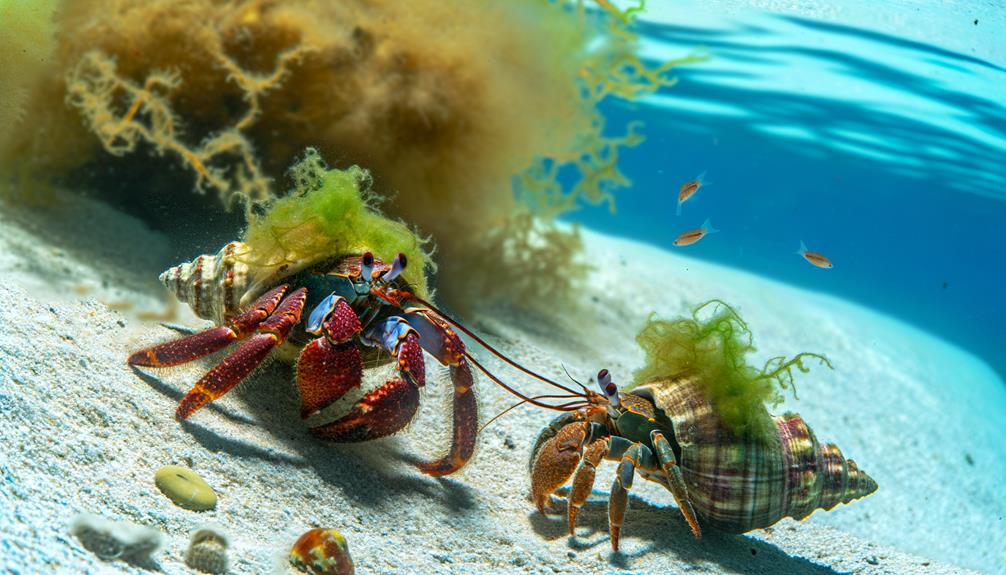How Do Hermit Crabs Fight Over Shells?
Yes, hermit crabs do fight each other, often due to competition for limited resources like suitable shells and mating opportunities. They engage in aggressive behaviors, such as shell rapping and claw grappling, to establish dominance and secure essential needs.
Physical confrontations are more common when resources are scarce, directly impacting their survival and reproductive success. Ensuring an adequate supply of appropriately sized shells can help reduce aggression and promote a more stable social hierarchy.
By understanding their behavior, you can mitigate conflicts and enhance their well-being, promoting a more harmonious habitat. Explore further to grasp the intricacies of these fascinating interactions.

Key Takeaways
- Hermit crabs fight over limited resources, especially shells.
- Aggressive encounters help secure essential needs and ensure survival.
- Intense battles occur among males for reproductive opportunities.
- Shell competition establishes a dominance hierarchy among crabs.
- Providing a variety of shell sizes reduces aggression and promotes harmony.
Reasons for Fighting
Hermit crabs primarily fight over access to limited resources such as suitable shells and food. When resources are scarce, competition intensifies, leading to aggressive encounters. Observational studies have documented that hermit crabs will engage in physical confrontations to secure these essential needs. Such behavior guarantees their survival, as insufficient resources can impede growth and reproductive success.
By understanding these interactions, you can better appreciate their natural behavior and create environments that minimize conflict. Providing ample resources and monitoring their availability can significantly reduce the incidence of fighting. This knowledge empowers you to foster a more harmonious habitat, ultimately enhancing the well-being of these fascinating creatures.
It's vital to recognize their needs and act accordingly to support their thriving.
Shell Competition
You've got to understand that shell competition among hermit crabs is primarily driven by resource scarcity, which limits the availability of suitable shells.
Empirical evidence shows that crabs engage in aggressive behaviors to secure the best shells, establishing a dominance hierarchy.
This competition directly impacts their survival and reproductive success.
Resource Scarcity Impact
Facing limited resources, hermit crabs engage in aggressive shell competition, a behavior extensively documented in marine biology studies. When suitable shells become scarce, you'll witness heightened aggression among hermit crabs.
Research indicates that crabs often assess the size and condition of potential new shells before initiating conflict. Studies show that larger crabs frequently displace smaller ones, leading to a cascade of shell exchanges within the population.
This phenomenon underscores the critical need for adequate shell availability to maintain population stability. By understanding these dynamics, you can better advocate for marine conservation efforts that preserve natural habitats and resources.
Providing artificial shells or protecting shell-rich environments can mitigate these conflicts and promote a healthier ecosystem for hermit crabs.
Dominance and Hierarchy
In shell competition, dominance and hierarchy among hermit crabs are established through direct confrontations and physical displays of strength. You'll observe that larger crabs often initiate aggressive behaviors to displace smaller crabs from their shells. This behavior ensures that the fittest individuals secure the best resources, which is essential for their survival.
Researchers have documented that shell competition involves several key behaviors:
- Rapping: One crab repeatedly strikes the shell of another to force it out.
- Shell Ripping: The dominant crab uses its claws to physically remove the subordinate.
- Eviction: The victorious crab takes over the superior shell, leaving the evicted crab vulnerable.
Understanding these interactions can help you appreciate the complex social structures that govern hermit crab communities.
Social Hierarchy
How do hermit crabs establish their social hierarchy within their communities?
Hermit crabs form a social structure through shell exchanges and physical confrontations. Empirical evidence shows that larger crabs often dominate due to physical advantages. Hierarchical status is determined by shell possession, as shells provide protection and influence survival.
When a shell becomes available, crabs engage in shell rapping, a behavior where they tap each other's shells to assess strength. Dominant crabs claim superior shells, while subordinate ones settle for less advantageous options.
This hierarchy reduces unnecessary conflicts and promotes stability within the group. Understanding these dynamics enables you to better care for hermit crabs by ensuring they have suitable shells, thereby fostering a harmonious environment.
Mating Battles
Beyond establishing their social hierarchy, hermit crabs also engage in intense mating battles to secure reproductive opportunities. Male hermit crabs compete fiercely for access to females, often resulting in physical confrontations. These battles serve to demonstrate strength and fitness to potential mates, enhancing reproductive success.
- Aggressive displays: Males use their claws and bodies to intimidate rivals.
- Physical confrontations: Claw grapples and shell ramming are common tactics.
- Endurance tests: Prolonged fights can determine the most persistent and fit male.
These mating battles are driven by natural selection, favoring those who exhibit superior physical and behavioral traits.
Understanding these behaviors can help you appreciate the complex social dynamics and evolutionary pressures that shape hermit crab populations.
Fighting Techniques
Hermit crabs employ a variety of fighting techniques, including claw grappling and shell ramming, to assert dominance and secure resources. Claw grappling involves the use of their powerful claws to grasp and pull an opponent, often leading to dislodgement. Shell ramming, on the other hand, is when a hermit crab forcefully strikes another with its shell, aiming to unseat the rival from its protective housing.
| Technique | Description |
|---|---|
| Claw Grappling | Crabs grasp and pull opponents, often leading to dislodgement. |
| Shell Ramming | Crabs strike rivals with their shells to unseat them. |
| Antennae Touch | Crabs use antennae to sense and intimidate opponents. |
| Leg Kicking | Crabs kick with their legs to destabilize and deter competitors. |
Understanding these behaviors helps in ensuring their well-being and managing their habitats effectively.
Impact on Survival
Engaging in these combative behaviors directly influences a hermit crab's survival by determining access to essential resources like food and shelter. When hermit crabs fight, the outcomes can significantly affect their fitness and lifespan. Winning a battle often results in obtaining a superior shell, which offers better protection and reduces predation risks.
Conversely, losing can lead to:
- Increased vulnerability: A subpar shell leaves the crab exposed to predators.
- Energy depletion: Continuous fighting depletes energy reserves, weakening the crab.
- Social hierarchy disruption: Frequent conflicts can destabilize the social order, leading to increased stress and mortality.
Empirical evidence supports that hermit crabs with best-fit shells exhibit higher survival rates, underscoring the critical role of these combative interactions.
Preventing Conflicts
To mitigate conflict among hermit crabs, you should focus on proper habitat setup and providing an adequate supply of shells.
Empirical evidence suggests that a well-designed habitat with ample hiding spaces reduces aggressive interactions.
Additionally, ensuring a variety of appropriately sized shells can prevent competition-driven disputes.
Proper Habitat Setup
Ensuring a well-structured habitat for hermit crabs can greatly reduce the likelihood of conflicts. Research indicates that environment plays a crucial role in behavior.
To create an ideal habitat, adhere to these necessary guidelines:
- Space: Provide sufficient space, as overcrowding can lead to stress and aggression. A minimum of 10 gallons per crab is recommended.
- Substrate: Use a deep, moist substrate like coconut fiber or sand, allowing crabs to burrow and molt comfortably, which is essential for their health.
- Hiding spots: Incorporate various shelters and climbing structures. These features offer security and reduce territorial disputes.
Adequate Shell Supply
Regularly providing a sufficient supply of appropriately sized shells is crucial for preventing conflicts among hermit crabs. When multiple hermit crabs compete for limited resources, aggressive encounters increase, potentially leading to injury or death. Studies have shown that a higher availability of suitable shells correlates with reduced aggression.
You should aim to offer a variety of shell sizes to accommodate the growth and preferences of different individuals. Monitoring shell wear and replacement needs will guarantee a continuous supply. By maintaining an ample shell inventory, you'll foster a harmonious environment, minimizing the risk of conflict.
In doing so, you're not only enhancing the well-being of the hermit crabs but also promoting a sustainable and ethical habitat.
Conclusion
Simply put, hermit crabs mainly engage in battles because of shell competition, social ranking, and mating struggles. These conflicts encompass different fighting strategies and greatly influence their survival.
To lessen these confrontations, provide an abundant supply of appropriate shells and uphold ideal living conditions. Research indicates that decreasing rivalry can improve their welfare.
By comprehending the reasons and outcomes of their skirmishes, you can establish a more peaceful setting for your hermit crabs.






